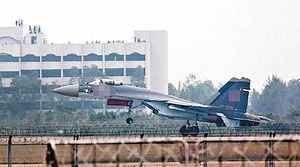Russia has completed the delivery of 24 Sukhoi Su-35S (NATO reporting name: Flanker-E) multirole fighter aircraft destined for service in the People’s Liberation Army Air Force (PLAAF), Russia’s Federal Service for Military-Technical Cooperation (FSVTS) told local media on April 16.
“In compliance with the contract, all the Su-35 planes have been delivered to the foreign customer,” FSVTS was quoted as saying by TASS news agency. A FSVTS official also confirmed the delivery of the fighter aircraft to China in a statement to IHS Jane’s on April 16. The official did not reveal when the last batch of aircraft was delivered.
In August 2018, the Russian Ministry of Defense (MoD) stated that all Su-35 aircraft would be delivered by year’s end. A first batch of four Su-35 fighter jets arrived at a flight training center of the PLAAF in Cangzhou City in Hebei province in northern China in December 2016. A second batch of 10 Su-35 fighter jets was delivered in December 2017.
China’s Ministry of National Defense (MND) confirmed in April 2018 that the Su-35 had officially entered service with the PLAAF. The following month, PLAAF Su-35s for the first time escorted an undisclosed number of Xian H-6K bombers and support aircraft during a long-range patrol over the Bashi channel and around the island of Taiwan on May 11.
China became the first international customer of the Su-35 when it signed a $2.5 billion contract for 24 aircraft in November 2015. Negotiations between Beijing and Moscow over the purchase of the Su-35 already began in 2011, with a initial sales agreement reached in 2012.
The sales agreement also includes the delivery of ground support equipment and spare engines, expected to be completed by 2020, according to a Russian military-diplomatic source. “Some additional subsystems, including ground-support hardware, have yet to be delivered. The customer will have received all the pieces of equipment by the end of the next year,” the source told IHS Jane’s.
Notably, a PLAAF source revealed to IHS Jane’s details about the armament suite for the aircraft: “The Su-35 will be complemented by air-to-air and air-to-ground missiles, as well as unguided rockets, guided bomb units and unguided bombs. The fighters will carry R-27 (AA-10 ‘Alamo’), R-73 (AA-11 ‘Archer’), and RVV-family [air-to-air] missiles and Kh-35E (AS-20 ‘Kayak’) anti-ship missiles.”
As I noted elsewhere:
The Su-35 is an upgraded fourth generation, twin-engine, multirole air superiority fighter aircraft powered by two AL-117S turbofan engines and fitted with thrust vectoring nozzles allowing the aircraft to attain “super maneuverability”.
Additionally, the aircraft features “an export-standard radar system — the Irbis-E passive-electronically scanned-array radar, capable of tracking up to 30 targets simultaneously and purportedly able to engage up to eight — an electronic warfare and communications suite, as well as a newly integrated receiver for the domestically-built BeiDou satellite navigation system. (…)
The per-unit cost of a Su-35 is estimated at around $85 million. Russia was initially hesitant to sell the Su-35 to China as it had concerns over Chinese reverse engineering of the aircraft’s powerful AL-41F1S, alternatively known as the ALS-117S, thrust-vectoring engine. According to multiple sources, China originally was interested in procuring the AL-41F1S as a stand-alone product.
The U.S. imposed sanctions on China for purchasing the Su-35s in breach of the congressionally mandated Countering America’s Adversaries Through Sanctions Act (CAATSA) in September 2018.
Indonesia will be the second foreign buyer of the Su-35.
































